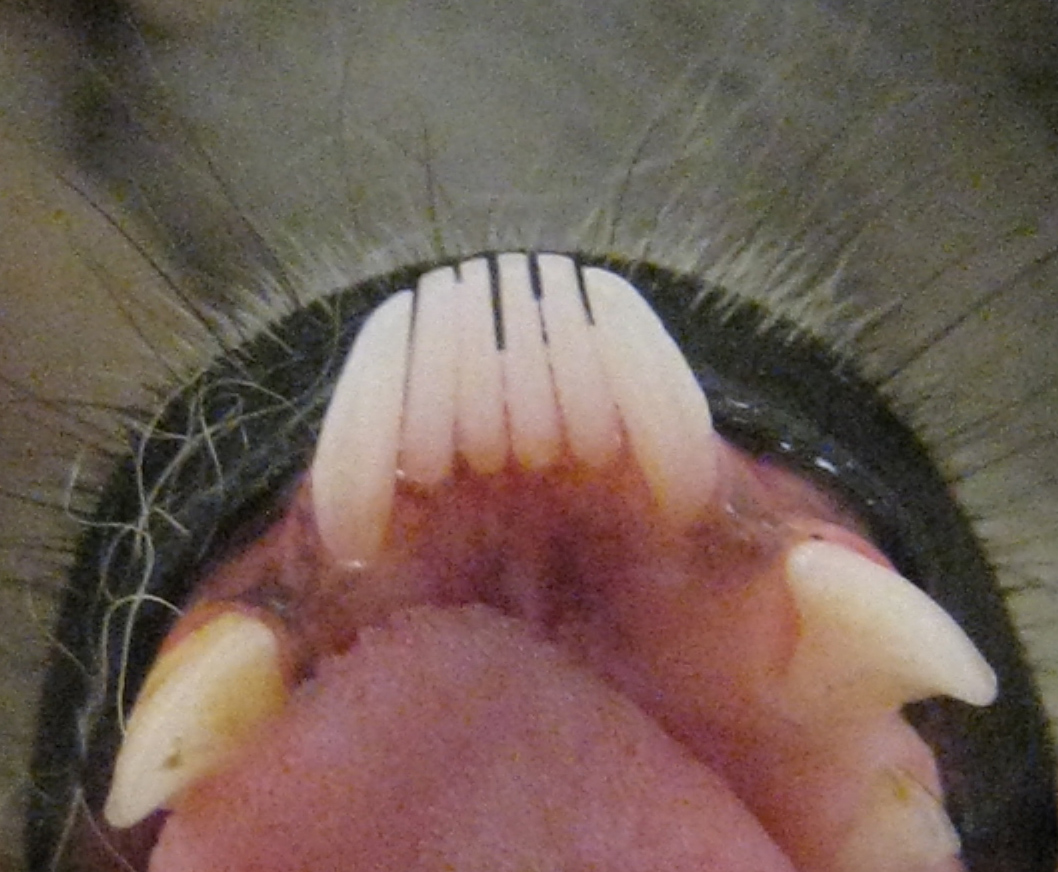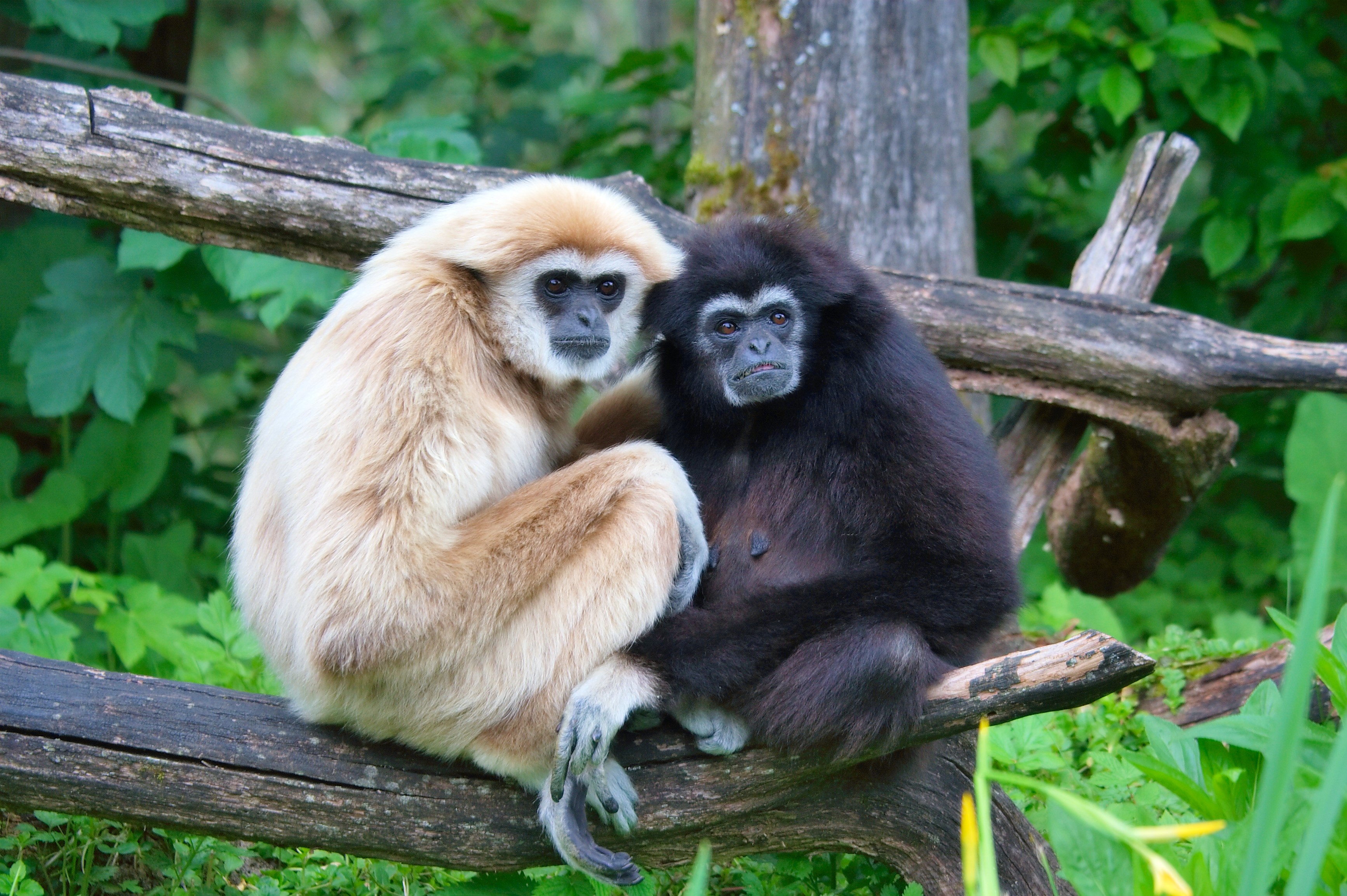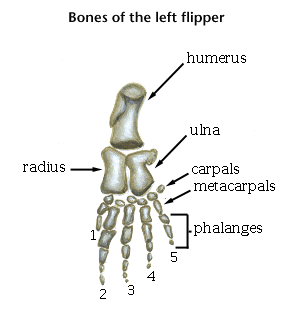Lemurs (Prosimians/ Strepsirhini)
 A.
A. Lemurs are only found the off the southeast coast of Africa on the islands of Madagascar and Comoro. Lemurs live in a variety of different habitats (tropical, desert, etc.) versus just one particular region. Though lemurs are found all throughout the islands, they are most commonly found in the overgrown forests due to their being rich in food. Lemurs are arboreal, meaning they live in trees. However, this is only the majority of lemurs, there are larger species that live on the ground. Lemurs eat a variety of different nuts and fruits. They move around a home range during the day to secure their food. They move to different locations for sleeping purposes in order to remain safe from predators.
 B.
B. Lemurs do not have sexual dimorphism based on size, however they do posses other differences that are more common among one sex. For example, the male lemur's upper canines are longer than those of the female. Also, the male's antebrachial gland is larger and thus more visible. More obviously though, the male's scrotum is clearly visible and a dead give away as to the difference in the sex.
C. Being arboreal, Lemurs are able to move quickly and virtually invisibly through the trees. They have adapted to living high up, away from most predators. Lemurs have small bodies which aid them in their ability to move quickly and hide in crowded places.
Sources:
http://www.lemurworld.com/lemur-habitat.html
http://library.sandiegozoo.org/factsheets/ringtailed_lemur/lemur.htm
Spider Monkey (New World Monkey/ Platyrrhini)
 A.
A. Spider monkeys live in the tropical forests of Central and South America. They are arboreal creatures meaning they, as well as lemurs spend most of their time aloft in the trees. Spider moneys have prehensile tails that allow them to grip and swing from branch to branch without thumbs. These primates are social and gather in groups of up to two or three dozen animals. They split up at night for sleeping in groups of half a dozen or less. Spider monkeys find food in the tree tops where they rather enjoy munching on nuts, fruits, leaves, bird eggs, and spiders. They communicate through a variety of calls and screeches.
 B
B.Spider monkeys have slight sexual dimorphism in their size. Males are slightly larger than female
spider monkeys. The male spider monkey generally weighs slightly more than the female spider monkey. Males tend to travel in subgroups with all other males where as women tend to travel alone or with their offspring.
C. Spider monkeys are small and light allowing them to quickly and silently move from tree to tree. Spider monkeys They are strong an have prehensile tails which allows them to remain in the trees away from their predators.
Sources:
http://animals.nationalgeographic.com/animals/mammals/spider-monkey/
http://link.springer.com/article/10.1007%2FBF02382267
Baboon (Old World Monkey/ Cercopithecidae)
 A.
A. There are five different species of baboons, all of which live in Africa or Arabia. Baboons are one of the largest monkeys in existence. The average male weighs thirty three to eighty two pounds and measures twenty to forty inches in length not including their tails. Baboons generally live in the savanna, but a few also inhabit the tropical forests. Unlike new world monkeys, baboons do not have prehensile tails, however they are able to climb trees to eat, sleep and scope out trouble. Baboons spend the majority of their time on the ground. Baboons are omnivorous meaning they enjoy plants and vegetables as well as meat.
 B.
B. Male baboons are much larger than female baboons. Male baboons weigh about forty pounds where as females weigh closer to twenty pounds. Facial size and shape are other examples of sexual dimorphism among baboons. Female baboons' heads and faces growth slows much earlier than that of the male.
C. Baboons do not have prehensile tails, but they are still able to climb trees. This is because baboons have very opposable fingers and thumbs which aid them in gripping a variety of things. Their size helps them to hunt their prey and gather the other foods they enjoy eating.
Sources:
http://www.ncbi.nlm.nih.gov/pubmed/2021194
http://pin.primate.wisc.edu/factsheets/entry/gelada_baboon
http://animals.nationalgeographic.com/animals/mammals/baboon/
Gibbon (Lesser Ape/ Hylobatidae)
 A.
A. Gibbons inhabit the forests of Southeastern Asia. They are adapted to the trees and rarely descend to the ground. There are fifteen species of gibbons. They are tailless with hook shaped hands and long arms used to grip branches and reach faraway limbs. They can move through the jungle swinging from tree to tree at up to thirty five miles per hour. They are they most bipedal of non human primates. Gibbons are monogamous and live in family groups. They eat fruit, especially figs. Gibbons weigh nine to twenty nine pounds depending on species.
B. Gibbons have very slight sexual dimorphisms in size aside from the siamang speciies. Although they do not generally have a size difference, they do have differences in fur color, in fact the difference is so great that the two almost appear to be a different species. Female white cheeked gibbons have cream colored fur with a tiny patch of black on the top of their head. Male gibbons are completely black except for white patches on their cheeks. When gibbons are born, their fur is the same cream colored fur of their mother. After a year of age, their fur turns black. As the gibbons age, the females fur returns to the cream color of their mother's where as the males fur remains black.
C. The fur color of the gibbons is used as a sort of camouflage. The fur of the mother and her offspring being the same color helps to aid the mother gibbon in protecting her young from predators as it makes blending more simple. Gibbons being able to swing from tree to tree at high speeds helps them as well because they are able to quickly get away from their predators.
Sources:
http://www.czs.org/czs/Brookfield/Exhibit-and-Animal-Guide/Tropic-World/White-Cheeked-Gibbon
http://anthro.palomar.edu/primate/prim_7.htm
http://animals.nationalgeographic.com/animals/mammals/gibbon/
Chimpanzee (Great ape/ Hominidae)
 A.
A. Chimpanzees are forest animals. They are primarily found in the rain forest and in wet savannas. The majority of their sleeping and eating is in trees making them arboreal, although they spend equal time on land also making them terrestrial. The chimpanzee has a thick set body with long arms, short legs and no tail. Chimps live in groups, also known as troops of thirty to eighty individuals made up of all females, all males or a variety of the two. They are quadrupedal, walking with their fingers half flexed to support their weight on their knuckles. Chimps are agile climbers, building nests high up in trees to rest in during midday. They are omnivores and eat about eighty different varieties of plants as well as hunt monkeys, and even eat infants of other chimpanzee groups.
B. There is sexual dimorphism among chimpanzees regarding size. Males are larger than females weighing one hundred pounds
and growing to be about five and one half feet tall. Female chimps are only around eighty two pounds and are much less muscular. Chimpanzees are male dominant with intense aggression between groups.
C. The size difference of the chimps helps the male show that he is more dominant. Both sexes are large and great hunters. Being large and heavy helps them because they are more ofthen the predator rather than the prey.
Sources:
http://www.outtoafrica.nl/animals/engchimpanzee.html
http://anthro.palomar.edu/primate/prim_7.htm
http://www.eva.mpg.de/3chimps/files/apes.htm
Summary
Every species, majorly or minimally, is affected by the environment. In my research i learned that all species adapt to their environment based on their needs and the resources available to them. I found that many of these primates have only slight sexual dimorphisms in size. This is very interesting but true for humans as well. The average woman is not much smaller than a man as far as height is concerned. I also learned about these primates environments and habits which was very interesting as i did not know many of the details involved in the adaptation of these species to their environments.
 The Piltdown Hoax was discovered in Piltdown, England in 1912 by Charles Dawson. The news that an ancient human jaw bone had been found spread quickly among the community.Dawson quickly acted on his discovery by contacting Arthur Woodward, a geologist, who joined Dawson and helped to discover more skull fragments. Many people thought of this discovery as the "missing link" between humans and apes until it was recently discovered that this finding
The Piltdown Hoax was discovered in Piltdown, England in 1912 by Charles Dawson. The news that an ancient human jaw bone had been found spread quickly among the community.Dawson quickly acted on his discovery by contacting Arthur Woodward, a geologist, who joined Dawson and helped to discover more skull fragments. Many people thought of this discovery as the "missing link" between humans and apes until it was recently discovered that this finding  The positive aspects responsible for the revealing of the skull to be a fraud are fluorine, which helped the scientists by revealing the fragments' actual age. While examining the fragments after finding out that the age was a hoax, scientists also found that the bones had been stained, filed and cut to appear older, more human like, and to camouflage the evidence of them being orangutan skull fragments rather than human.
The positive aspects responsible for the revealing of the skull to be a fraud are fluorine, which helped the scientists by revealing the fragments' actual age. While examining the fragments after finding out that the age was a hoax, scientists also found that the bones had been stained, filed and cut to appear older, more human like, and to camouflage the evidence of them being orangutan skull fragments rather than human.











